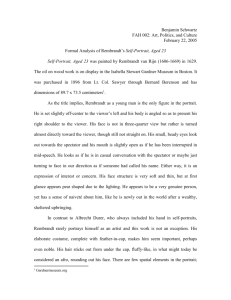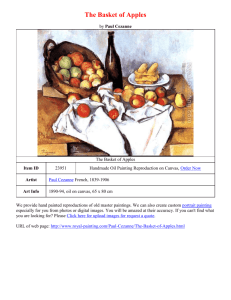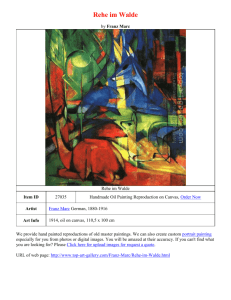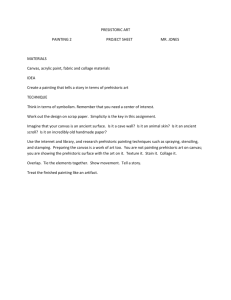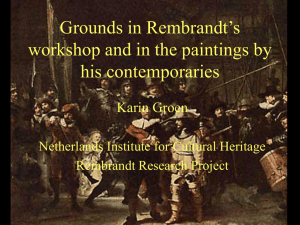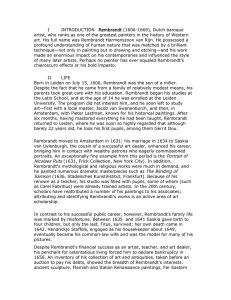Art Humanities: Masterpieces of Western Art - arthumanities
advertisement
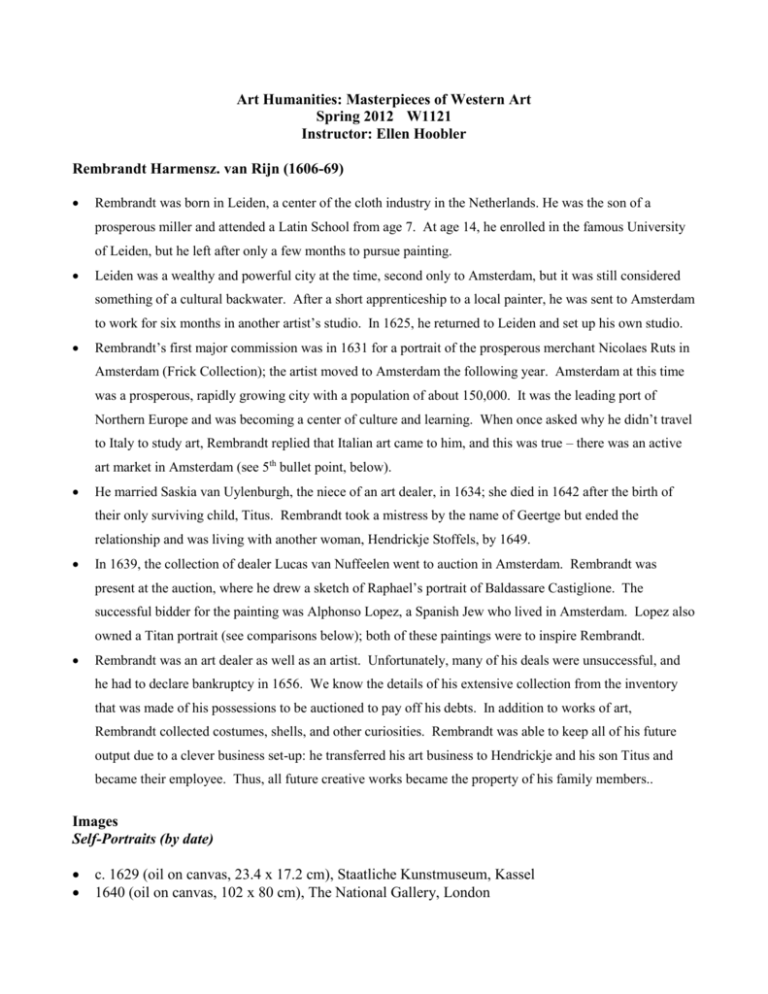
Art Humanities: Masterpieces of Western Art Spring 2012 W1121 Instructor: Ellen Hoobler Rembrandt Harmensz. van Rijn (1606-69) Rembrandt was born in Leiden, a center of the cloth industry in the Netherlands. He was the son of a prosperous miller and attended a Latin School from age 7. At age 14, he enrolled in the famous University of Leiden, but he left after only a few months to pursue painting. Leiden was a wealthy and powerful city at the time, second only to Amsterdam, but it was still considered something of a cultural backwater. After a short apprenticeship to a local painter, he was sent to Amsterdam to work for six months in another artist’s studio. In 1625, he returned to Leiden and set up his own studio. Rembrandt’s first major commission was in 1631 for a portrait of the prosperous merchant Nicolaes Ruts in Amsterdam (Frick Collection); the artist moved to Amsterdam the following year. Amsterdam at this time was a prosperous, rapidly growing city with a population of about 150,000. It was the leading port of Northern Europe and was becoming a center of culture and learning. When once asked why he didn’t travel to Italy to study art, Rembrandt replied that Italian art came to him, and this was true – there was an active art market in Amsterdam (see 5th bullet point, below). He married Saskia van Uylenburgh, the niece of an art dealer, in 1634; she died in 1642 after the birth of their only surviving child, Titus. Rembrandt took a mistress by the name of Geertge but ended the relationship and was living with another woman, Hendrickje Stoffels, by 1649. In 1639, the collection of dealer Lucas van Nuffeelen went to auction in Amsterdam. Rembrandt was present at the auction, where he drew a sketch of Raphael’s portrait of Baldassare Castiglione. The successful bidder for the painting was Alphonso Lopez, a Spanish Jew who lived in Amsterdam. Lopez also owned a Titan portrait (see comparisons below); both of these paintings were to inspire Rembrandt. Rembrandt was an art dealer as well as an artist. Unfortunately, many of his deals were unsuccessful, and he had to declare bankruptcy in 1656. We know the details of his extensive collection from the inventory that was made of his possessions to be auctioned to pay off his debts. In addition to works of art, Rembrandt collected costumes, shells, and other curiosities. Rembrandt was able to keep all of his future output due to a clever business set-up: he transferred his art business to Hendrickje and his son Titus and became their employee. Thus, all future creative works became the property of his family members.. Images Self-Portraits (by date) c. 1629 (oil on canvas, 23.4 x 17.2 cm), Staatliche Kunstmuseum, Kassel 1640 (oil on canvas, 102 x 80 cm), The National Gallery, London 1658 (oil on canvas, 133.7 x 103.8 cm), Frick Collection, New York 1660 (oil on canvas, 80.3 x 67.3 cm), Metropolitan Museum of Art, New York Self Portrait with Saskia (Prodigal Son in a Tavern) c. 1635, (oil on canvas, 5’3” x 4’4”) Alte Meister Gallerie, Dresden, Germany Group Portraits The Shooting Company of Captain Frans Banning Cocq (The Night Watch), signed and dated 1642, (oil on canvas, 387 x 502 cm, [143 x 172 in]), Rijksmuseum, Amsterdam Drawings and Etchings Portrait of Baldassare Castiglione after Raphael, 1639 (pen and ink, 163 x 207), Albertina, Vienna Comparisons Raphael, Portrait of Baldassare Castiglione, c. 1514-15 (oil on canvas, 82 x 66 cm), The Louvre, Paris Vocabulary: Chiaroscuro -- The prominent contrast of light and shade in a painting, drawing or print, and the way the artist manages those shadows to create the illusion of solid three-dimensional forms. Impasto -- The Italian word 'Impasto' (dough or paste) denotes a painting technique in which undiluted paint is applied so thickly (like toothpaste) onto the canvas or panel (often with a palette knife) that it stands out from the surface. When using this impasto technique, the artist often mixes paint on the canvas itself to achieve the required colour. Impasto is especially important in conveying a three dimensional impression. Baroque painters like Rembrandt, Hals and Velázquez used painstakingly worked impastos to depict lined or wrinkled skin, folds in robes, or the glint of jewelry. The rough texture can also draw attention to certain points or aspects of a composition. Mahl Stick / Maulstick -- A mahl stick is a stick or thin pole about a metre in length (three feet) with a ball-shape pad at one end, used as an aid in painting. A mahl stick is useful when painting detail, particularly far from yourself on the canvas, or when painting in a large area where the paint is still wet and you want to avoid touching the surface accidentally. Resources (all on Butler Reserves) Alpers, Svetlana. Rembrandt’s Enterprise: the Studio and the Market. Chicago: University of Chicago, 1988. Especially chapter 1, “The Master’s Touch” White, Christopher. Rembrandt. London: Thames and Hudson, 1984.
